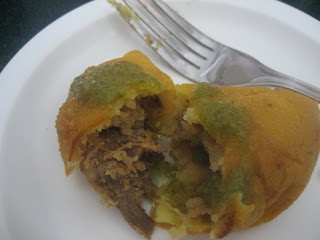My tiny hometown in rural Tennessee has never been a mecca for international exchange, but when I was 13, Blanca arrived from Colombia to spend a year living with my minister’s family. The main thing I remember about her is the speed and joy with which she motored around the kitchen, making the most delectable food with no recipes and seemingly, on autopilot. I remember that it was exotic and really tasty, but I don’t recall any details beyond that. At the time I was more concerned with boys and music than international culinary experiences. But Blanca was happy to share dishes from home with the rest of us. Having the opportunity to cook what she missed must have helped ease the disconnection I’m sure she felt. I’m sorry I didn’t have the presence of mind to ask her to show me how to make any of those foods.
Those good memories came back to me recently when I discovered Café Colombia, which is close to our house here in Los Angeles. This past week Himself and I, along with his parents, went there to check it out. We met Reinaldo and Gabriela, who have been serving the Colombian community–and the rest of LA–with really good Colombian food for about 10 years now.
We started with arepas, which are considered by many to be the national food of Colombia. Our sampler plate of three included one made of a fine white corn flour, topped with queso fresco and served cold, and two made of yellow cornmeal and filled with cheese–one was sweet and the other, savory. The arepa is a good walking-around food, tasty and filling. If you don’t have time to sit down and eat, this cross between a pancake and a tortilla is the way to go. Himself said the yellow corn arepas reminded him of the cornbread his West Virginia grandmother used to make, crispy and thin and cooked on the stovetop.
The empanadas were small and dense, filled with flavorful beef and served with ají, a general-purpose dipping sauce of cilantro, green onions, chilis, lemon juice and vinegar. Déjà vu alert! The sambosas I had in the Afghan restaurant recently were fried pastries filled with beef, dipped in a cilantro-jalapeno-vinegar chutney. Curious how people on different sides of the globe can come up with practically the same dishes, sauces and cooking procedures independently of each other.
Ajiaco is my new favorite soup. It’s essentially a really good chicken-potato soup with a big have-it-your-way component. Along with the soup comes an array of ingredients you can add or leave out: capers, rice, avocado and sweet cream (of course, I wanted it all in there). I bought a bottle of dried guascas, the essential herb in ajiaco, so that I can start making it at home. Guascas has its own unique flavor–I can’t think of another herb you could substitute for it. This soup calls for three different types of potatoes, a couple of waxy ones that hold their shape, and a russet-styled potato that breaks down in the soup to thicken it and give it body.
For a light finish we shared obleas, which look like a couple of communion wafers sandwiching a layer of caramel, or arequipe. And yes, we had some Colombian coffee (the richest kind, as Mrs. Olsen always told us). Café Colombian, café Americain style. It has been so long since I’ve ordered a plain ol’ cuppa coffee in a restaurant (as opposed to those ubiquitous coffee drinks) that I’d forgotten that a good cup of coffee doesn’t need all the frills and add-ins to satisfy.
I’ve always assumed that food from south of the United States is spicy as a matter of course. This would be a logical assumption, considering that these countries are closer to the equator, where spices and peppers are indigenous. But the only spicy component in any of our Colombian dishes was the ají sauce served on the side. Everything was wonderfully flavorful and rich but not at all hot or what you’d call spicy. That’s a revelation for me.























You make a great point about seasoning misconceptions. Many people assume that the food will be overly spicy or hot. As you shared, that is not always the case and in most places, not really applicable. No need to be worried about the heat…just focus on the richness of the foods.
I like very much the idea of adding layers of caramel to the communion bread, too!